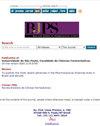蜂胶抗人感染致病菌活性的研究
IF 0.9
4区 医学
Q4 PHARMACOLOGY & PHARMACY
引用次数: 0
摘要
蜂胶是一种树脂状的蜂箱产品,蜜蜂从植物的花蕾或其他部分收集蜂胶。众所周知,它具有多种生物特性,包括抗真菌活性。蜂胶中的类黄酮和酚酸及其酯类物质是蜂胶抗真菌的主要成分。这意味着蜂胶是替代医学中理想的抗真菌剂,用于治疗由念珠菌和其他酵母样真菌、皮肤真菌和非皮肤真菌引起的许多局部和全身感染,而没有合成治疗的典型严重副作用。它还对对多烯和唑类药物具有耐药性的真菌菌株具有活性,这两种药物是最常用于治疗真菌感染的药物。本文综述了世界各地蜂胶及其成分体外和体内抗人感染病原菌活性的最新研究进展。并对蜂胶及其成分的抑菌作用机制进行了初步探讨。本文章由计算机程序翻译,如有差异,请以英文原文为准。
The activity of propolis against pathogenic fungi isolated from human infections
Propolis is a resinous hive product collected by bees from the buds or other parts of plants. It is known for having various biological properties, including antifungal activity. Among the substances present in propolis, flavonoids and phenolic acids and their esters are responsible for its antifungal properties. This means that propolis is ideal for use as an antifungal agent in alternative medicine to treat a number of both topical and systemic infections caused by Candida species and other yeast-like fungi, dermatophyte and nondermatophyte moulds, without the serious side effects typical of synthetic treatment. It is also active against strains of fungi that are resistant to polyenes and azoles, the classes of drugs most commonly used to treat fungal infections. In this article, we review current knowledge about the activity of propolis from different parts of the world and its components in vitro and in vivo against pathogenic fungi isolated from human infections. The article also indicates the possible mechanism of antifungal activity of propolis and its components.
求助全文
通过发布文献求助,成功后即可免费获取论文全文。
去求助
来源期刊

Brazilian Journal of Pharmaceutical Sciences
PHARMACOLOGY & PHARMACY-
CiteScore
1.40
自引率
0.00%
发文量
165
审稿时长
7.5 months
期刊介绍:
The Brazilian Journal of Pharmaceutical Sciences accepts for publication Original Papers applicable to the fields of Pharmaceutical Sciences; Reviews and Current Comment Articles, which are published under the Scientific Editor and Associate Editors invitation to recognized experts or when they are spontaneously submitted by the authors in the form of abstracts to have their importance evaluated. A critical view of the subject with insertions of results of previous works in the field in relation to the state of art must be included; Short Communications reporting new methods and previews of works on researches of outstanding importance in which originality justify a quick publication. A maximum of 2000 words excluding tables, figures and references is an acceptable limit. One table, one figure and ten references may be added, and Book Reviews of the latest editions of books, prepared by specialists invited by the Scientific Editor and Associate Editors. Thematic Supplements as well as those related to scientific meetings can be published under the Scientific Editor and/or Associate Editors agreement.
 求助内容:
求助内容: 应助结果提醒方式:
应助结果提醒方式:


